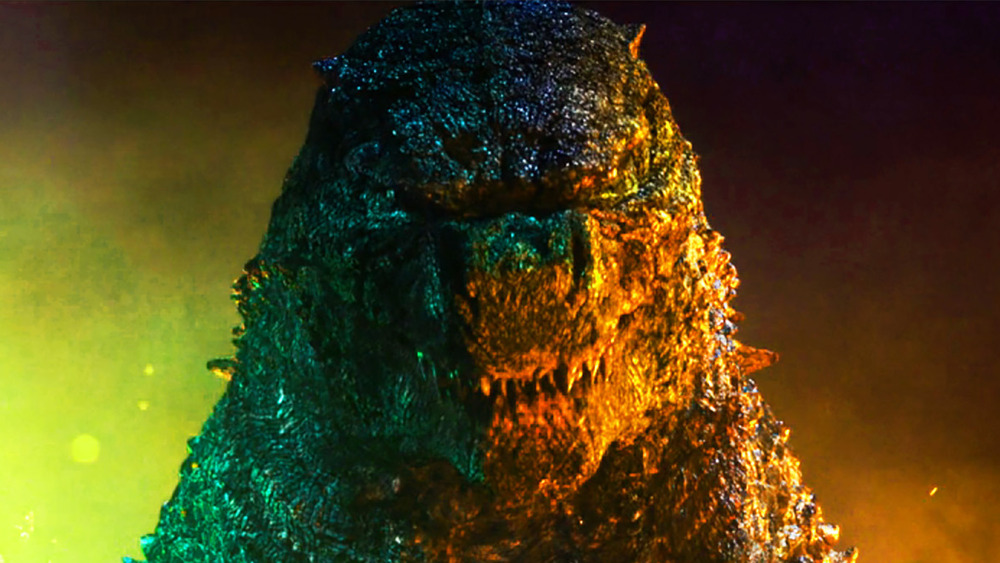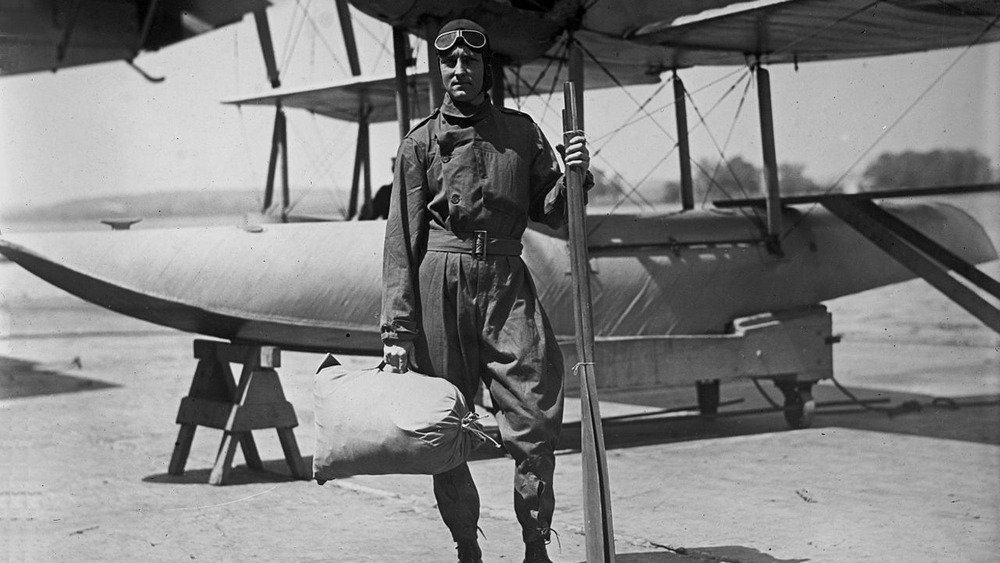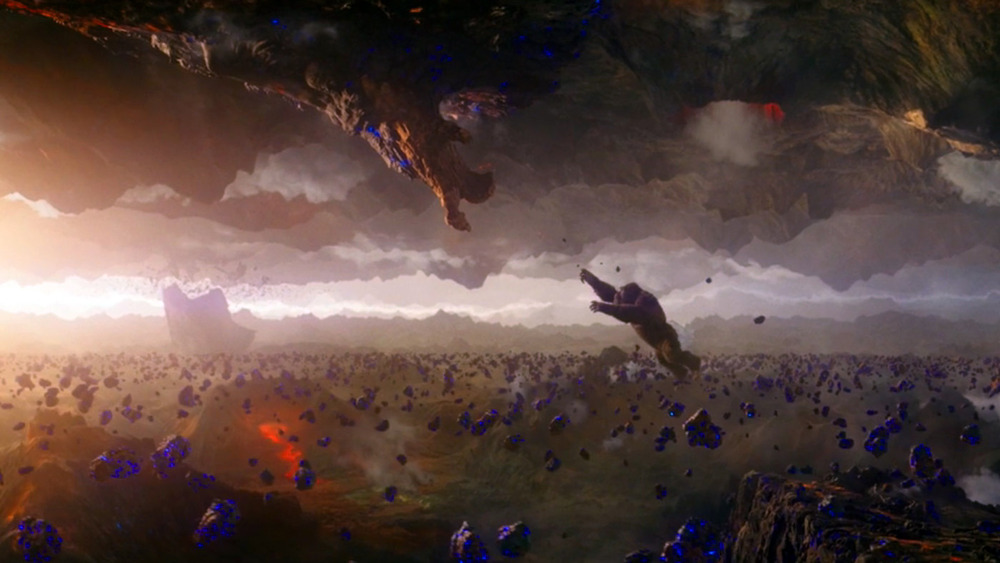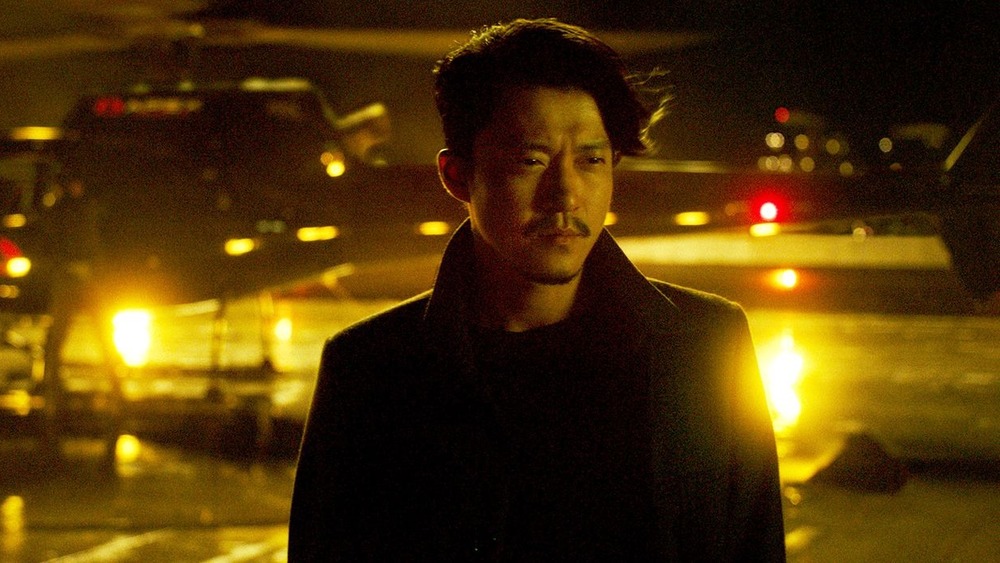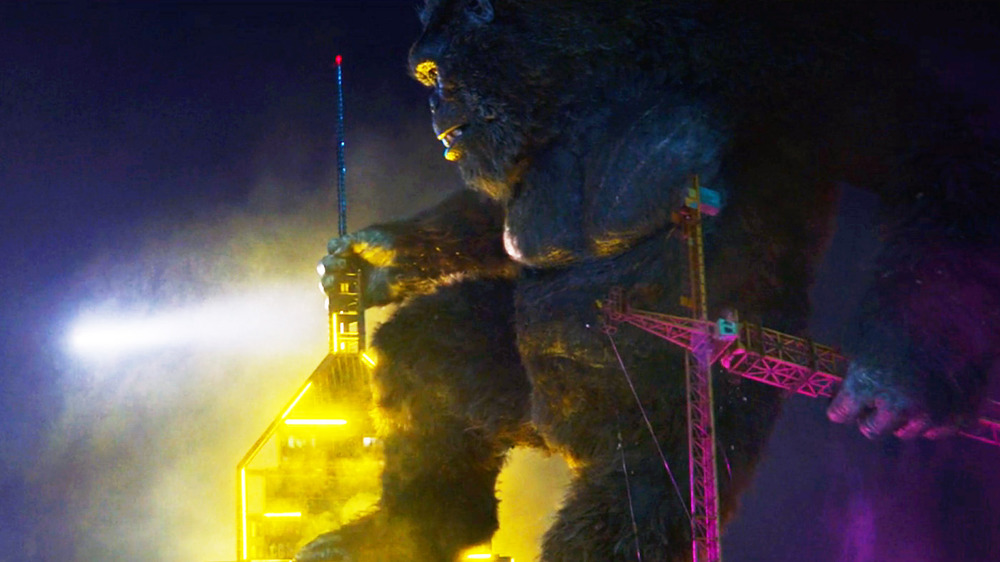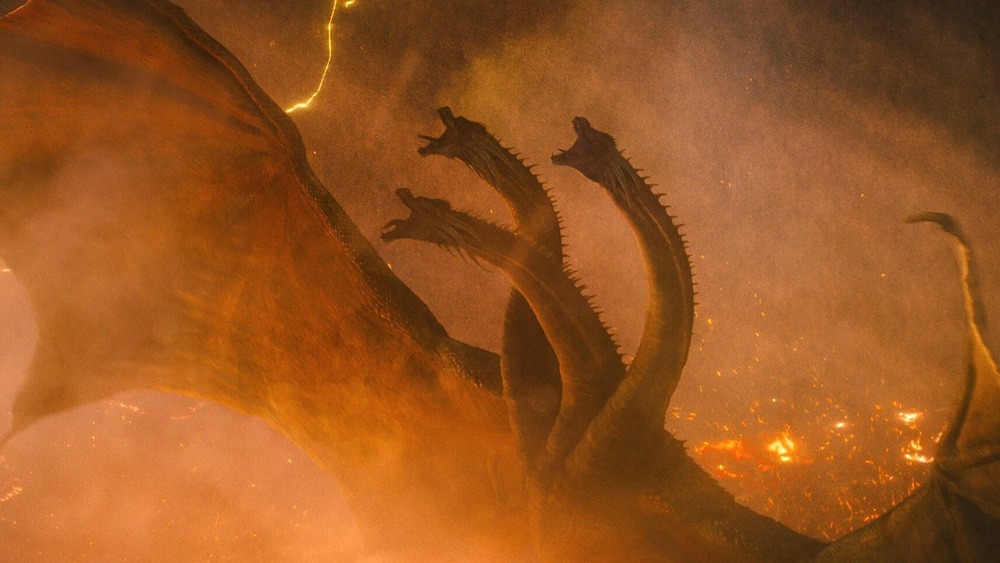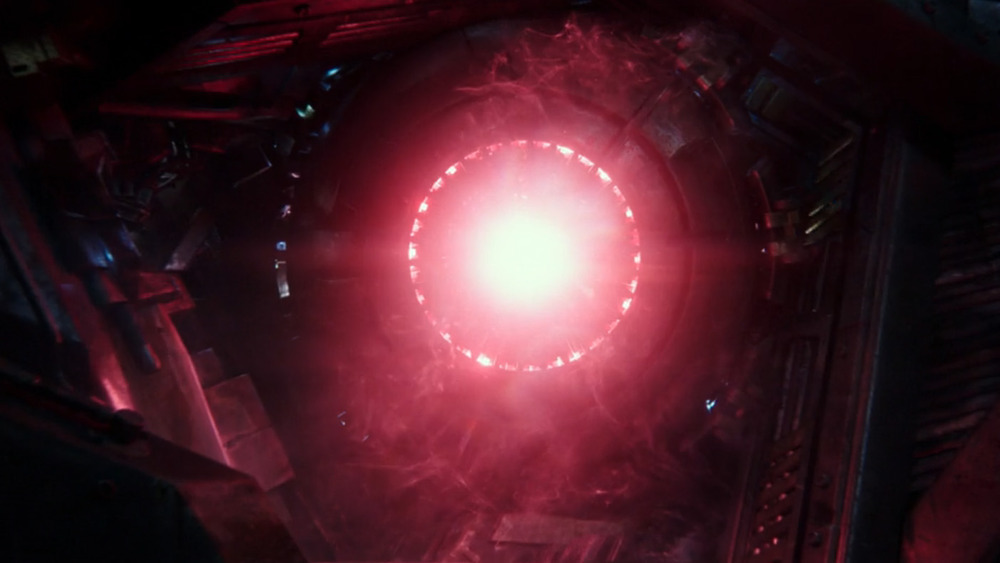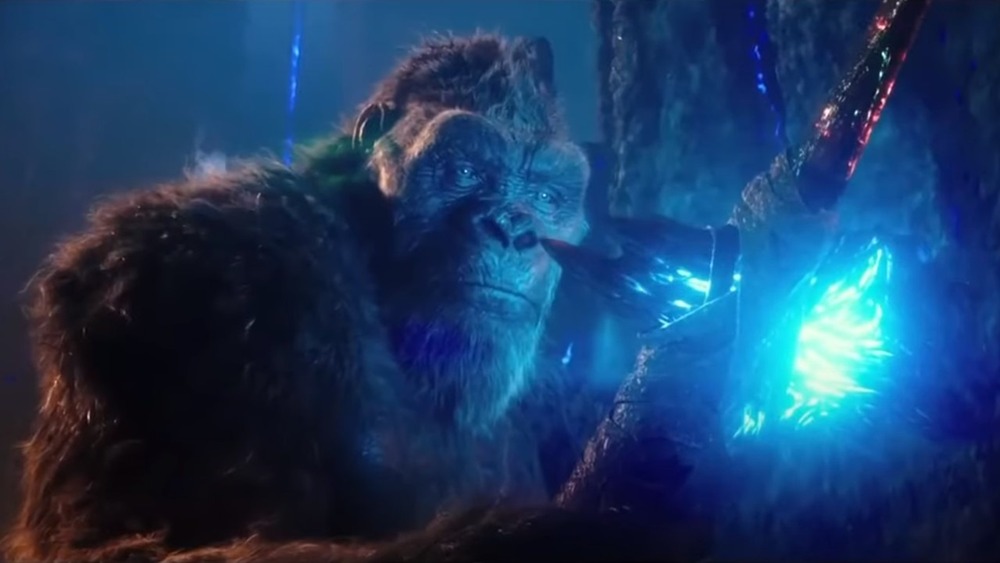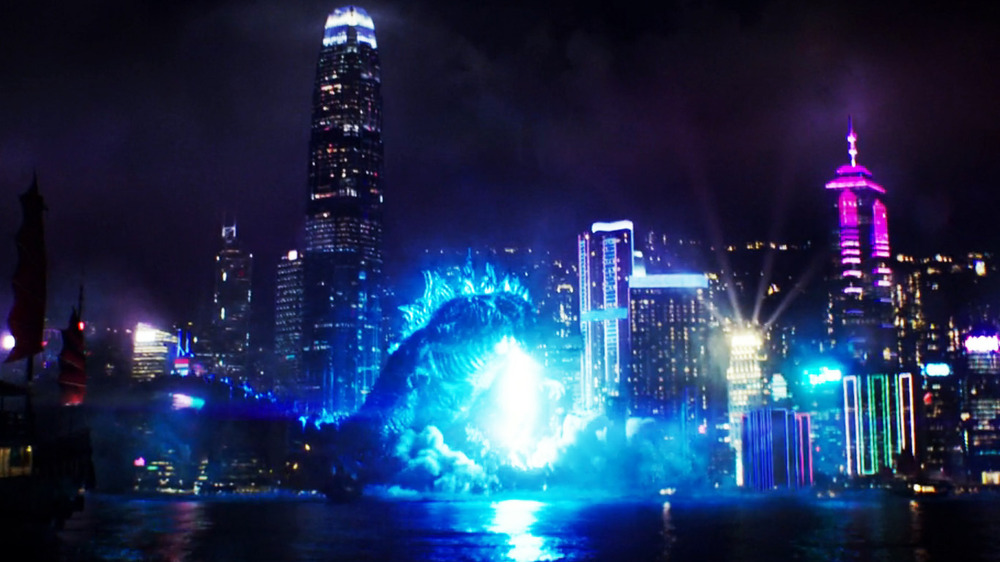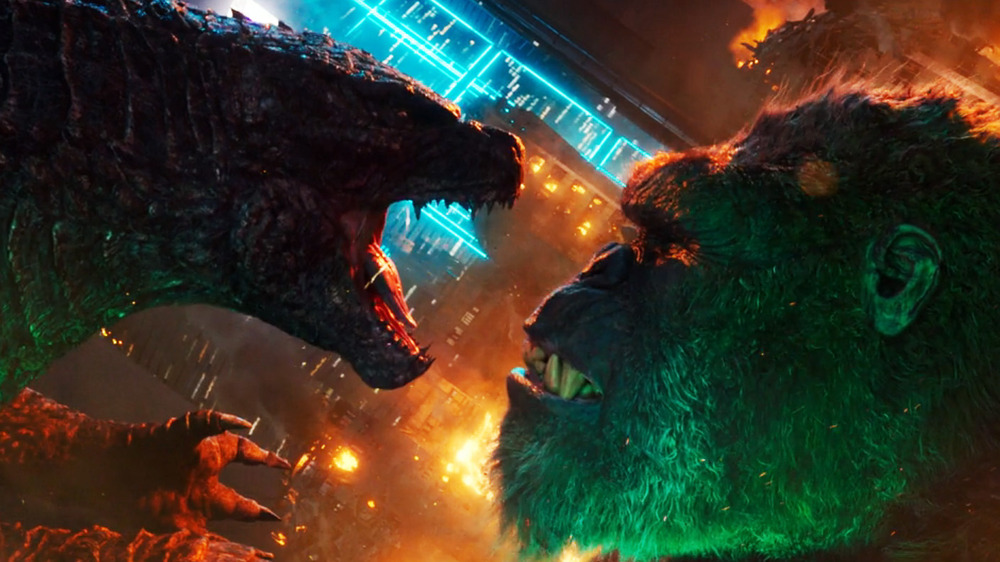Confusing Moments In Godzilla Vs. Kong Explained
If you want to see two giant monsters clobber each other, Godzilla vs. Kong is for you. If you want a coherent plot? Eh, not so much. Director Adam Wingard's titanic blockbuster absolutely delivers on the heavyweight brawl promised in the title, but it's very, very light on logic. This is the kind of movie that focuses mostly on spectacle. Enjoy the big battle, and don't pay too much attention to the story parts.
However, while Godzilla vs. Kong is full of moments that don't seem to make much sense, a lot of it actually does hold together. You just need to do a little work to make all of the pieces fit. Sometimes, this means looking to previous MonsterVerse entries for explanations. Sometimes, you'll have to look outside of the film to interviews done by Godzilla vs. Kong's production staff. Occasionally, you can find the answers in historical documents, or by heading online to see how other fans have decided to connect all of the dots.
Or you can just keep reading. We've already done the work, so you can sit back, relax, and enjoy the best part of the movie: the epic fight between Godzilla, king of the monsters, and Kong, the eighth wonder of the world. All those confusing bits? Leave those to us.
What is Operation Highdrop, and who discovered Hollow Earth?
In Godzilla vs. Kong, major concepts get brief bits of exposition. Hollow Earth, for example, is a major plot point but most of its history is only laid out during the opening credits. For example, the montage reveals that Hollow Earth isn't just one giant landscape. As hinted in Godzilla: King of the Monsters, Hollow Earth is a series of "vast caverns and air pockets," connected by a series of tunnels. It's not a particularly new discovery, either. As the credits state, in 1926, an American admiral led an expedition to the North Pole, although it's not clear if he found Hollow Earth.
This admiral is very clearly supposed to be Richard E. Byrd, a real-life figure who's inexorably linked to the idea of Hollow Earth. In 1926, Byrd voyaged to the North Pole, although whether he actually succeeded is a matter of debate. Further, one of Byrd's "lost" journal entries allegedly describes encounters with giant animals and long-lost humans in a tropical climate hidden somewhere beneath the Earth.
The problem? The document in question is dated 1947, when Byrd was taking part in Operation Highdrop — another name dropped in Godzilla vs. Kong's credits — and exploring the South Pole, not the northern one. Still, Byrd has become a pivotal figure in the Hollow Earth conspiracy theory (yeah, that's a real thing, too), and it looks like Godzilla vs. Kong has done some minor historical retcons to legitimize his story, making him one of the first Hollow Earth pioneers, at least in the MonsterVerse.
How do physics work in Hollow Earth?
Even if you accept the idea that there are tunnels burrowing through Earth, hiding tropical landscapes and long-lost civilizations, Godzilla vs. Kong's Hollow Earth is a little confusing. The "gravity paradox" allowing Kong to jump Mario Galaxy-style from one landmass to another (and making entry to Hollow Earth so dangerous) doesn't really make sense. Also, it's awfully bright down there, given that the sun is on the other side of the Earth's surface.
Godzilla vs. Kong never explicitly explains how all of this works, but it's easy to come up with some suitable theories. After all, the concept of Hollow Earth has been a mainstay in mythology or folklore for centuries. The idea got its first scientific introduction in 1692, when astronomer Edmond Halley posited that there was a second, hollow sphere inside of Earth with its own, separate set of magnetic poles. Hollow Earth theory has been with us ever since. In fact, some people believe it to this day.
In 1913, Marshall Gardner published A Journey to the Earth's Interior, which argues that there could be a second, smaller sun inside the Earth, which might be the source of Hollow Earth's light and its wonky physics. Jules Verne's Journey to the Center of the Earth, while explicitly fiction, uses electromagnetic phenomena, a "luminous cloud" of gas, and glowing lichen to explain why there's light inside. Of course, in this case, the simplest explanation may be the best: Some fans think that Earth's core provides both gravity and light to Hollow Earth. Hey, as far as pseudoscience goes, it works. Kind of.
Who is Ren Serizawa?
Ren Serizawa, Apex Cybernetics' CTO and Mechagodzilla's ill-fated pilot, gets a big introduction in Godzilla vs. Kong, but doesn't really seem like much more than a hired goon in the end. Why give such a minor character so much focus? There's actually a very good reason: You wouldn't catch this unless you're all caught up on your MonsterVerse lore, but as Ren's last name implies, he's the son of Monarch scientist Ishiro Serizawa, who was played by Ken Watanabe.
Ishiro first appeared in 2014's Godzilla, where he served as an advocate for the big lizard, and returned for 2019's Godzilla: King of the Monsters, in which his bond with the Titan grew even closer. Correctly surmising that Godzilla was nature's defense against both the Titans and environmental ruin, Serizawa sacrificed his life to detonate the nuclear bomb that nursed an injured Godzilla back to health, giving the monster the strength he needed to stop Ghidorah and his reign of terror.
According to an alleged (and, in hindsight, completely accurate) leak of Godzilla vs. Kong's shooting script, Ren was supposed to take after his father. He helped create Mechagodzilla not to stop the Titan but to fight alongside him, believing, like Ishiro, that Godzilla was Earth's savior. Unfortunately, those scenes were cut, robbing Ren of any kind of depth and turning him into a much more generic villain. Still, if that means Godzilla vs. Kong was able to devote more time to the titular brawl, it was worth it.
How did Kong get so big?
In Godzilla vs. Kong, Kong looks very different from when we last saw him in Kong: Skull Island. Basically, he's bigger. A whole lot bigger. In Skull Island, which takes place in 1973, the ape is a mere 104 feet tall (that's also the size for Kong listed in Godzilla vs. Kong's opening credits). By 2024, when Godzilla vs. Kong takes place, he's grown to 335 feet, according to an official poster for the movie.
There's an obvious reason for the size change. In order to make Kong a credible threat to Godzilla, who stands at a whopping 394 feet, Kong needs to be in at least the same weight class. However, there's an in-universe reason as to why Kong grew over 300% bigger, too. According to Godzilla vs. Kong producer Alex Garcia, Kong is still a growing boy. "There's a line in Skull Island that he's still growing, so he's an adolescent in that film," Garcia says. By the time Godzilla vs. Kong rolls around, he's still gone through a major growth-spurt — and, as far as we know, will keep getting larger.
Either way, this is a major upgrade for Kong, who was only 18 feet tall during the jungle scenes in his 1933 debut feature, and 24 feet in the sequences set in New York City. That makes sense, though. In the 1933 movie, Kong has to climb the Empire State Building, which stands at 1,250, and is taken out by a handful of biplanes. In Godzilla vs. Kong, he's knocking over entire skyscrapers without a second thought. So, yeah, it's a big difference.
Why does Mechagodzilla hate Godzilla?
If you thought that, hey, maybe building a robotic titan out of one of the most dangerous kaiju ever was a bad idea, then guess what? You were right. As Godzilla vs. Kong reveals, Mechagodzilla was constructed out of two skulls harvested from Godzilla: King of the Monsters' main villain, the three-headed monster known as both Monster Zero and Ghidorah. One skull is inside the robot. The other houses the piloting interface that Ren Serizawa uses to control Mechagodzilla, and communicates with the mechanical Titan using Ghidorah's innate psychic abilities.
At least, that's the plan. When Apex injects Mechagodzilla with the Hollow Earth power source, Ren loses control of the beast. The movie doesn't make this entirely clear, so just in case you were wondering: This isn't just Mechagodzilla going rogue. In this moment, Ghidorah's consciousness actually takes over Mechagodzilla's mechanical body, bringing him back to life.
This is important for two reasons. One, it makes the following Godzilla vs. Mechagodzilla fight much more personal. This is a grudge match. Both monsters have personal stakes. Two, it provides one of Godzilla vs. Kong's most obscure Easter eggs. In the 2002 movie Godzilla Against Mechagodzilla, Mechagodzilla is built from the bones of the first Godzilla, who died in the original 1954 movie. As in Godzilla vs. Kong, this doesn't end well. The current Godzilla's roar triggers Mechagodzilla's latent memories and drives it mad, sending it on a rampage that only Godzilla can stop. The parallels should be obvious.
What is that device Bernie finds in Apex's lab?
Teenage monster-hunter Madison (Millie Bobby Brown), conspiracy theorist Bernie (Brian Tyree Henry), and Julian Dennison's "hacker" Josh (hey, he knows HTML!) go on a pretty circuitous journey while uncovering Apex's plans for Mechagodzilla. First, Bernie downloads classified information from an Apex computer, learning that the company is making many mysterious shipments to Hong Kong. Next, he sneaks into a restricted area in Apex's Pensacola laboratory, catching a glimpse of an ominous device during the middle of Godzilla's attack.
Later, Bernie takes Madison and Josh to see the machine, only to discover it's missing. From there, the trio get caught in one of the Hong Kong-bound crates. There, they learn that the mystery cargo consists of Skullcralwer eggs, which are usually only found on Skull Island. Once they're in Hong Kong, the unlikely investigators see a live Skullcrawler — and watch, horrified, as Mechagodzilla utterly destroys it, finally revealing Apex's master plan.
That's a very roundabout way to reveal Mechagodzilla, and you'd be forgiven for losing some of the plot along the way. For example, what is that thing that Bernie sees during Godzilla's initial onslaught? While some fans seem to think that it's a variation on the ORCA device used to lure Titans in Godzilla: King of the Monsters, and Bernie seems to forget about it entirely once Mechagodzilla is revealed, it looks like it's one of Mechagodzilla's glowing red eyes. Look at the close-up on the eye when Mechagodzilla wakes up. It's clearly the same thing.
How does Kong's axe work?
Godzilla relies on more than just brute strength. In addition to his size, he has a number of powers, including his iconic atomic breath, that he uses to decimate his foes. And so, in order to give Kong a fighting chance, Godzilla vs. Kong had to even the odds by giving the giant primate an axe, which comes with some special abilities of its own. Not only is the axe key to unlocking Hollow Earth's ultra-potent power source, but it can absorb Godzilla's atomic breath and dish it back to him.
However, Godzilla vs. Kong only hints at where the axe came from, and doesn't spend much time explaining how it works. For that, you need to turn to a Collider interview with Godzilla vs. Kong writer and key MonsterVerse contributor Max Borenstein.
"To me, it's like Godzilla's scales have this conductive, radioactive quality," Borenstein explains, "and the primate Kongs had a kind of evolved civilization of sorts, as primates might, and simple tools, and had used the spine of a Godzilla creature to create it." So, yeah, the axe blade's resemblance to Godzilla's back spikes isn't an accident. The axe is literally made out of the body of Godzilla's ancestor.
Other than that, Borenstein isn't saying much else about the axe's history, although there's clearly more there to explore. "It's something that we just kind of tease at in the movie and hopefully we can explore in later films," director Adam Wingard says, coyly.
What's going on with the tunnel that Godzilla creates to Hollow Earth?
One of the coolest moments in Godzilla vs. Kong occurs when Godzilla, suddenly alarmed by Kong's activation of the Hollow Earth energy source, fires up his atomic breath and blows a hole to the center of the Earth, opening a new passage from Hollow Earth to the surface. It's also, unfortunately, one of the most confusing. How does Godzilla know what Kong is up to, for one, and why doesn't the gravity barrier that made travel between the two realms so difficult seem to apply here?
The answer to that first question is implied, although not outright stated, in the previous MonsterVerse films. The first MonsterVerse film, 2014's Godzilla, establishes that Titans like Godzilla are drawn to immense power sources, especially nuclear ones. When Kong powers up the Hollow Earth throne room, it seems likely that Godzilla simply detected the energy surge, particularly if his "genetic memory" — something we know the Titans have — kicked in. After all, they're probably encountered the energy before.
As for the second, well, there are a few possible explanations. Maybe Godzilla's atomic breath disrupted the barrier that separates Hollow Earth from our world. Maybe the veil only applies to the Hollow Earth tunnel at the North Pole — in Godzilla: King of the Monsters, for example, Monarch's submarine has a much easier time reaching Godzilla's Hollow Earth hideout.
Most likely, however, is that the sequence is just awkwardly cut. We see Kong and the Hollow Earth expedition's HEAV head into the tunnel, but we don't see most of their time passing through. Besides, when he emerges, Nathan yells, "We're about to breach the veil," so it seems like it still happens. It's just not as visually spectacular as before. By that point in the story, there's plenty else to look at, after all.
Who won?
Godzilla vs. Kong director Adam Wingard promised that the titular brawl would have a definitive winner, and he didn't lie. However, some viewers seem to think that the movie ended in a draw. It's easy to see how they'd reach that conclusion. Like the best superhero team-ups, Kong and Godzilla ultimately put aside their differences and work together to take out the bad guy, Mechagodzilla. By the time the credits roll, the two Titans have struck up a begrudging truce and gone their separate ways. Now, Godzilla rules over the surface, while Hollow Earth is Kong's domain.
Before they make an uneasy peace, however, the epic clash has a clear winner: Godzilla. There's no doubt about it. Kong and Godzilla battle two times in the movie, once while Kong is en route to the North Pole, and again in Hong Kong. The first fight isn't even close. The fight begins with Kong drugged and shackled, and takes place in the ocean, Godzilla's home turf. The monkey doesn't stand a chance.
The second fight is more even, thanks to the neutral ground and Kong's axe, but Godzilla still has the upper hand. Yes, after absorbing Godzilla's atomic breath with his axe and delivering a near-knockout blow, Alexander Skarsgård's Nathan Lind says, "Looks like round two goes to Kong." But just a few minutes later, Godzilla is back on his feet, and Kong gets beaten so hard that his heart begins to stop.
Even if you take Nathan at his word and treat the two stages of the Hong Kong fight as separate, that still gives Godzilla a two-to-one advantage. Face it: Kong might be cinematic royalty, but when it comes down to it, Godzilla is the true king of the monsters.
